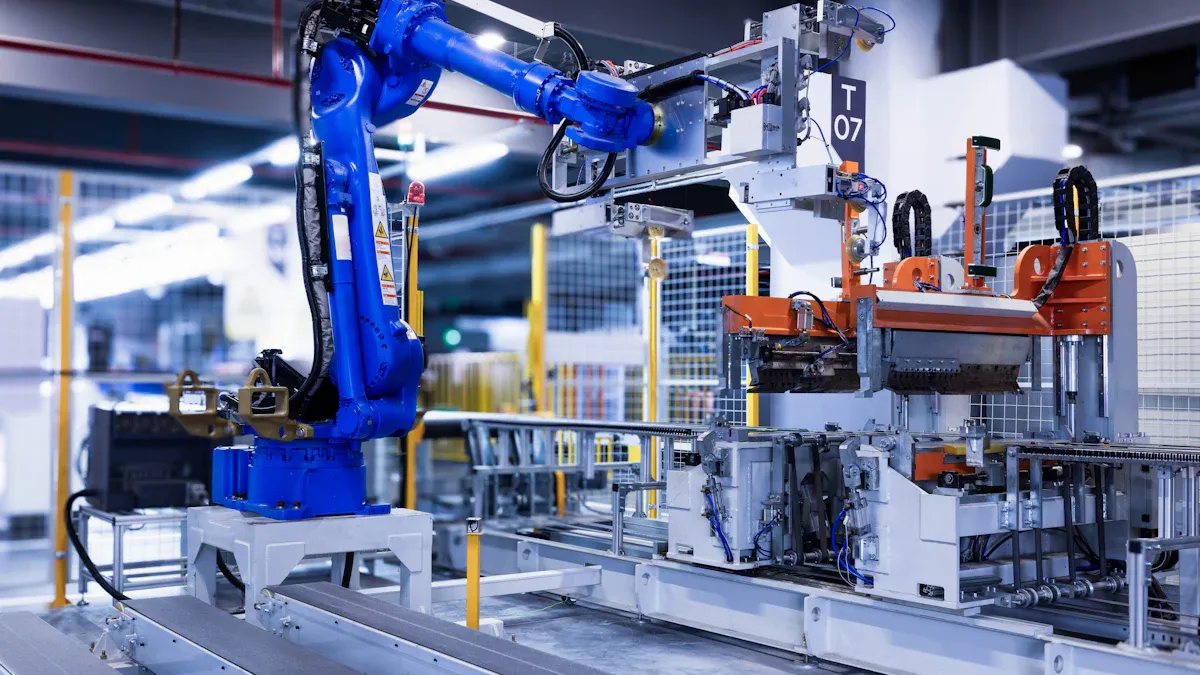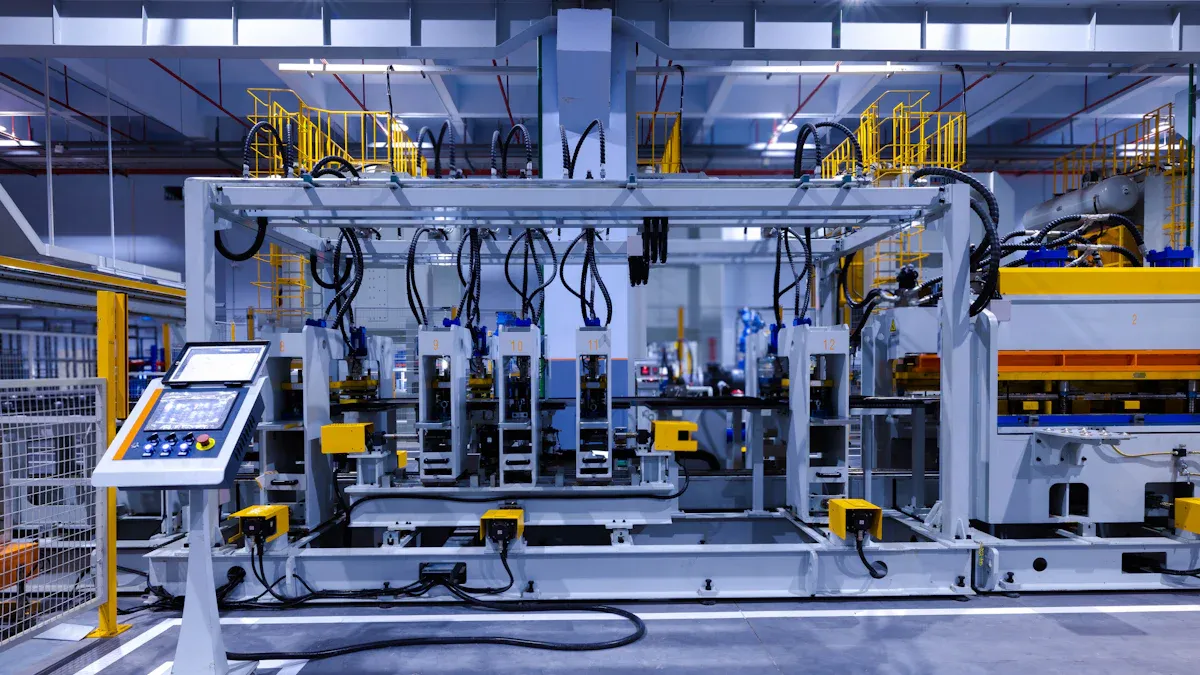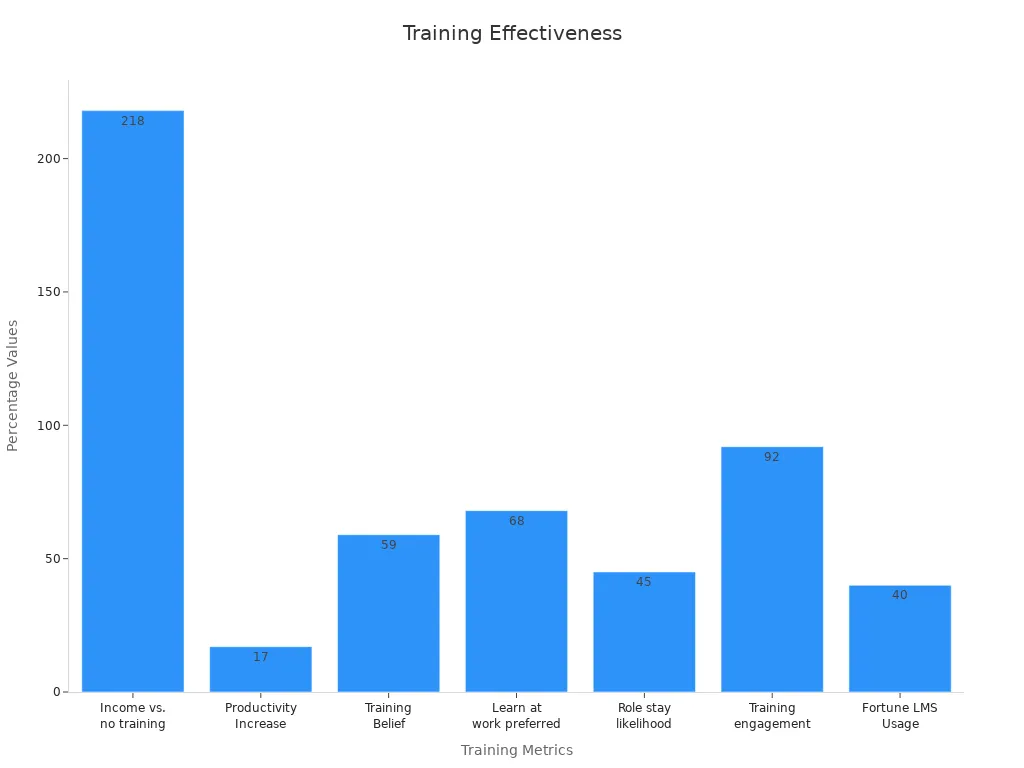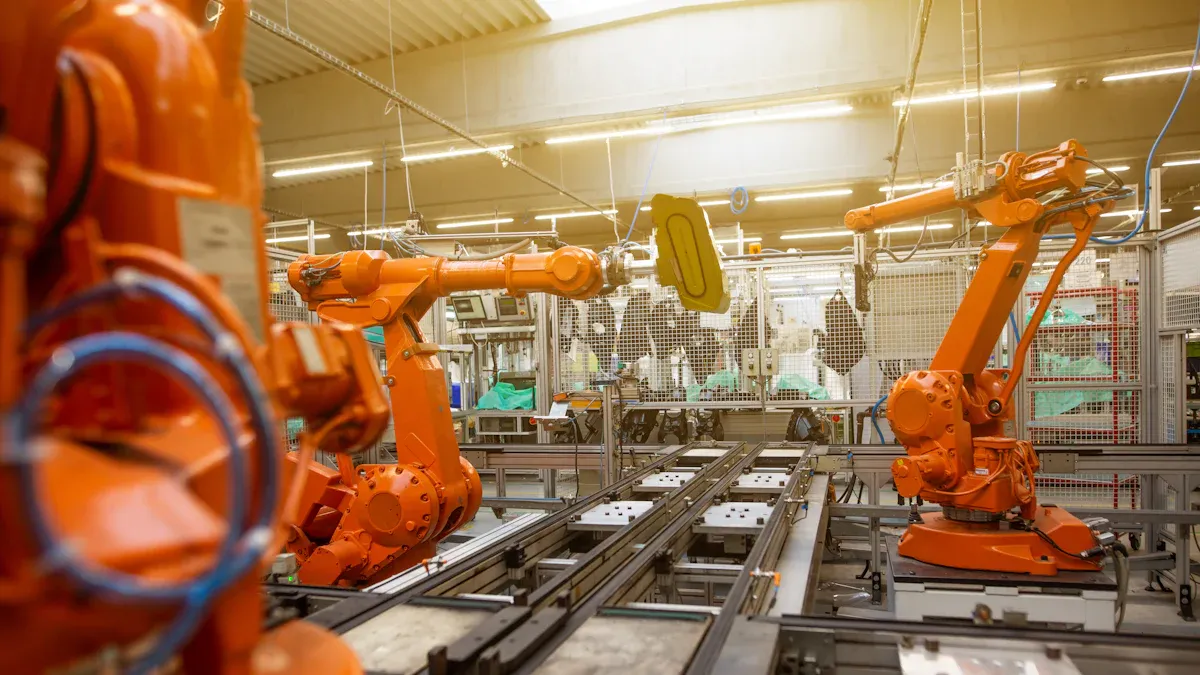
Integrating making machines into a lighter production line transforms operational efficiency. These machines automate repetitive tasks, enabling continuous workflows that exceed human labor limitations. As a result, factories witness increased output and reduced production costs. Lower labor dependency leads to savings, which can benefit consumers through competitive pricing. Additionally, seamless machine communication ensures precision, enhancing product quality and consistency. By adopting this approach, manufacturers position themselves for long-term scalability and reliability in the competitive lighter industry.
Key Takeaways
- Using machines to make things faster helps save time and money.
- New machines improve product quality with accurate work and checks.
- Fixing problems early prevents delays and keeps work running smoothly.
- Checking what is needed helps decide where to use machines best.
- Picking the right machines means checking their features, cost, and ease of use.
- Training workers well helps them use machines better and make fewer mistakes.
- Watching how things work shows what can be improved for better results.
- Making sure new machines work with old ones avoids problems and helps everything run well.
Understanding the Lighter Production Line
Key Components of a Lighter Production Line
A lighter production line consists of several critical components that ensure smooth operations and high-quality output. Each element plays a specific role in the manufacturing process, contributing to the overall efficiency of the system.
- Machinery Requirements: Specialized machines handle tasks such as injection molding, assembly, and quality control. These machines are designed for precision and high repeatability.
- Raw Materials: Essential materials include plastic resins, metal components, and flammable gases. Consistent quality of these inputs ensures reliable product performance.
- Utility Requirements: Reliable power supply, compressed air systems, and ventilation are necessary to maintain operational safety and efficiency.
- Plant Layout Considerations: An optimized layout minimizes material handling time and ensures smooth workflow between different production stages.
- Infrastructure and Manpower Needs: Adequate infrastructure, such as storage facilities and workstations, supports production. Skilled operators and technicians are essential for machine operation and maintenance.
- Packaging and Transportation Requirements: Proper packaging protects lighters during transit, while efficient logistics ensure timely delivery to markets.
In addition to these components, project economics play a vital role in the success of a lighter production line. Factors such as capital expenditure (CapEx), operating expenditure (OpEx), and income projections must be carefully analyzed. Manufacturers often evaluate profitability through metrics like payback period and net present value (NPV).
Common Challenges in Traditional Production Lines
Traditional lighter production lines face several challenges that can hinder efficiency and profitability. These issues often stem from outdated processes and limited automation.
- High Labor Dependency: Manual operations increase the risk of human error and slow down production rates. This dependency also raises labor costs, impacting overall profitability.
- Inconsistent Product Quality: Variability in manual processes can lead to inconsistencies in lighter dimensions, assembly, or functionality. Such issues affect customer satisfaction and brand reputation.
- Frequent Downtime: Older machinery often requires frequent maintenance, leading to unplanned downtime. This disrupts production schedules and delays order fulfillment.
- Inefficient Resource Utilization: Poorly designed workflows and plant layouts result in wasted materials and energy. This inefficiency increases operating costs and reduces profit margins.
- Limited Scalability: Traditional production lines struggle to adapt to changing market demands. Scaling up production often requires significant investment in new equipment and infrastructure.
Addressing these challenges is crucial for manufacturers aiming to stay competitive in the lighter production industry. Integrating advanced making machines and optimizing workflows can resolve many of these issues, paving the way for improved efficiency and profitability.
Making Machines and Their Role in Efficiency

What Are Making Machines?
Making machines are specialized equipment designed to automate and streamline manufacturing processes. In the context of a lighter production line, these machines handle tasks such as injection molding, assembly, and quality control with unparalleled precision. They operate using advanced technologies, including robotics, artificial intelligence (AI), and sensor-based systems, to ensure consistent performance and high-quality output.
Historically, the evolution of making machines has been shaped by technological advancements. From the Antikythera mechanism in 100 BC to modern AI-powered systems, these innovations have revolutionized manufacturing. For example, the introduction of electromechanical arithmometers in the 1920s laid the groundwork for automated production. Today, AI-driven machines can perform real-time quality checks, adjust operations based on demand, and predict maintenance needs, making them indispensable in modern manufacturing.
Functions of Making Machines in Lighter Production
Making machines play a pivotal role in enhancing the efficiency of lighter production lines. Their functions include:
- Automated Assembly: Machines assemble lighter components with speed and accuracy, reducing human error and ensuring uniformity.
- Quality Control: AI-powered systems monitor product quality at every stage, ensuring only defect-free lighters reach the market.
- Predictive Maintenance: By analyzing real-time data, machines identify potential issues before they lead to breakdowns, minimizing downtime.
- Process Optimization: Machines adjust production speeds and switch product types automatically, enabling quick responses to market demands.
- Resource Management: Advanced systems optimize the use of raw materials, reducing waste and lowering production costs.
Operational data further illustrates their impact. For instance, production cycle events track resource utilization, while sensor data ensures equipment health and product quality. These metrics highlight the critical role of making machines in achieving operational excellence.
Benefits of Integration
Reduced Downtime
Integrating making machines into a lighter production line significantly reduces downtime. AI-driven systems continuously monitor equipment performance, identifying issues before they escalate into failures. Predictive maintenance ensures machines remain operational, preventing costly disruptions. According to industry data, facilities that implement Total Productive Maintenance (TPM) experience 50-80% fewer breakdowns, leading to smoother operations and higher productivity.
Improved Precision
Making machines enhance precision by automating complex tasks. AI systems perform quality checks at high speeds, ensuring consistent product dimensions and functionality. This level of accuracy minimizes defects and boosts customer satisfaction. For example, General Electric’s use of additive manufacturing reduced production times by 50% while maintaining exceptional quality standards. Such advancements underscore the importance of precision in modern manufacturing.
Scalability and Flexibility
The integration of making machines allows manufacturers to scale operations efficiently. These machines adapt to changing production requirements, such as increased demand or new product designs. AI systems can automatically adjust production speeds and switch between product types, ensuring flexibility. This adaptability positions manufacturers to respond quickly to market trends, maintaining a competitive edge in the lighter production industry.
Tip: Investing in scalable and flexible making machines ensures long-term growth and resilience in a dynamic market.
Steps to Integrate Making Machines
Assessing Current Production Line Needs
Integrating making machines begins with a thorough assessment of the existing production line. Manufacturers must evaluate operational bottlenecks, inefficiencies, and areas requiring automation. This process involves analyzing production data, identifying repetitive tasks, and pinpointing quality control challenges.
A systematic approach ensures that integration aligns with the production line’s specific requirements. Research on smart manufacturing platforms highlights the importance of intelligent monitoring and maintenance protocols. By analyzing process outputs in relation to input parameters, manufacturers can develop tailored models that optimize workflows and enhance machine compatibility.
Additionally, machine learning applications provide valuable insights into production line monitoring. A review of 39 studies categorizes common production line problems and identifies algorithms that improve quality control and risk evaluation. These findings emphasize the role of data analytics in assessing production line needs and ensuring successful integration.
Tip: Conducting a comprehensive audit of the production line helps manufacturers identify areas where making machines can deliver maximum efficiency.
Selecting the Right Making Machines
Choosing the right making machines requires careful consideration of technical capabilities, cost-effectiveness, and usability. Manufacturers must evaluate how each machine aligns with their production goals and operational requirements.
Industry benchmarks and technical evaluations provide a structured framework for decision-making. The table below outlines key factors to consider:
| Factor | Description |
|---|---|
| Adoption cost | Assess the costs and workload required to implement the technology. The expected benefits must justify the investment. |
| Threat | Consider the risks associated with new technologies, including health, environmental, legal, and privacy concerns. |
| Capability | Evaluate what new capabilities the technology enables for the company and its potential benefits. |
| Usability | Determine how easy the technology is to use, as usability affects adoption rates significantly. |
Manufacturers should prioritize machines that offer scalability, precision, and reliability. For example, Ningbo Jiuqi Technology Co., Ltd. specializes in designing equipment with high production efficiency and stable performance, making their machines ideal for modern lighter production lines.
Note: Selecting machines that integrate seamlessly with existing systems reduces compatibility issues and ensures smoother implementation.
Implementing Automation Systems
Automation systems play a critical role in integrating making machines into production lines. These systems enable seamless communication between machines, optimize workflows, and enhance overall efficiency.
Case studies from various industries demonstrate the transformative impact of automation. For instance, a battery manufacturer automated the transfer of metallic plates, addressing ergonomic challenges and improving operational efficiency. Similarly, a powdered food manufacturer upgraded its spray dryer system, enhancing reliability and flexibility. These examples highlight the importance of tailored automation solutions in achieving production goals.
To implement automation systems effectively, manufacturers should:
- Develop a clear roadmap: Define integration objectives, timelines, and milestones.
- Leverage advanced technologies: Utilize AI-driven systems for real-time monitoring and predictive maintenance.
- Ensure compatibility: Test automation systems with existing equipment to avoid disruptions.
- Monitor performance: Use analytics to track system efficiency and identify areas for improvement.
Tip: Collaborating with experienced automation consultants can streamline the implementation process and ensure optimal results.
Training Staff and Monitoring Performance
Effective integration of making machines into a lighter production line requires more than just advanced technology. Properly trained staff and robust performance monitoring systems are essential for maximizing efficiency and ensuring long-term success. Employees must understand how to operate, maintain, and troubleshoot these machines to minimize errors and downtime.
Importance of Staff Training
Training equips employees with the skills needed to adapt to new technologies and workflows. It fosters confidence and competence, enabling operators to handle complex machinery with ease. Studies show that companies with comprehensive training programs experience a 218% increase in income per employee compared to those without. Additionally, productivity rises by 17% when employees receive adequate training.
Note: Training not only enhances individual performance but also contributes to overall organizational growth.
A well-structured training program should include:
- Hands-on Learning: Practical sessions allow employees to familiarize themselves with machine operations.
- Theoretical Knowledge: Understanding the principles behind machine functions helps in troubleshooting.
- Continuous Development: Regular updates ensure employees stay informed about the latest advancements.
Monitoring Performance for Continuous Improvement
Performance monitoring ensures that both machines and employees operate at optimal levels. Advanced monitoring systems track key metrics such as production speed, error rates, and machine health. These insights help identify areas for improvement and guide decision-making.
A recent survey revealed that 92% of employees believe training positively impacts job engagement, while 45% are more likely to stay in their roles if provided with development opportunities. This highlights the importance of combining training with performance monitoring to retain skilled workers and maintain operational efficiency.

Key Metrics to Track
Monitoring systems should focus on the following metrics to evaluate performance effectively:
- Machine Utilization Rates: Measure how efficiently machines are being used.
- Error Rates: Identify recurring issues to address through targeted training.
- Employee Productivity: Assess individual contributions to overall output.
- Downtime Analysis: Pinpoint causes of delays and implement corrective actions.
The table below highlights the impact of training and monitoring on employee performance:
| Statistic | Value |
|---|---|
| Income per employee with training programs vs. without | 218% higher |
| Increase in productivity with adequate training | 17% more productive |
| Employees who believe training improves performance | 59% |
| Employees satisfied with career advancement opportunities | Less than 33% |
| Employees who prefer to learn at work | 68% |
| Likelihood of staying in role with training | 45% more likely |
| Employees who won’t quit if given development opportunities | Over 90% |
| Employees who think training positively impacts job engagement | 92% |
| Fortune 500 companies using Learning Management Systems | 40% |
| Skills learned on the job vs. through formal training | 70% on the job, 10% formal |
Building a Culture of Learning
Organizations must foster a culture that values continuous learning and development. This involves:
- Encouraging Feedback: Regular feedback sessions help employees identify strengths and areas for improvement.
- Providing Resources: Access to learning materials and tools ensures employees can upskill effectively.
- Recognizing Achievements: Celebrating milestones motivates employees to excel further.
By prioritizing training and performance monitoring, manufacturers can unlock the full potential of their workforce and achieve seamless integration of making machines into their lighter production lines.
Overcoming Integration Challenges
Addressing Compatibility Issues
Integrating making machines into an existing lighter production line often presents compatibility challenges. These issues arise when new equipment fails to align with legacy systems, leading to inefficiencies or disruptions. Manufacturers must adopt a strategic approach to ensure seamless integration.
Key strategies for addressing compatibility issues include:
- Cultural Alignment: Aligning operational practices and workflows between old and new systems minimizes friction.
- Technology Integration: Ensuring that software and hardware systems communicate effectively prevents data loss or operational delays.
- Workforce Integration: Training employees to operate and maintain new machines fosters confidence and reduces resistance to change.
- Customer Retention: Maintaining consistent product quality during transitions safeguards customer satisfaction and loyalty.
- Legal and Regulatory Compliance: Adhering to industry standards and regulations avoids potential legal complications.
By prioritizing these strategies, manufacturers can mitigate risks and achieve a smooth transition. For example, Ningbo Jiuqi Technology Co., Ltd. designs equipment with high compatibility, ensuring minimal disruption during integration.
Tip: Conducting a compatibility audit before integration helps identify potential conflicts and develop targeted solutions.
Ensuring Proper Maintenance
Proper maintenance is critical for sustaining the performance of making machines. Neglecting maintenance can lead to frequent breakdowns, reduced efficiency, and higher operational costs. Manufacturers should implement a combination of predictive and preventive maintenance protocols to ensure optimal machine operation.
Effective maintenance strategies include:
- Predictive Maintenance: Utilizing IoT sensors and machine learning algorithms to monitor parameters like temperature and pressure. This approach predicts potential failures based on real-time and historical data.
- Preventive Maintenance: Scheduling regular maintenance activities to enhance machine longevity and performance.
- Continuous Monitoring: Integrating data from machine monitoring systems into cloud or edge computing platforms for real-time analysis.
- Digital Twins: Simulating machine operations to identify vulnerabilities and test solutions without disrupting production.
These strategies not only reduce downtime but also extend the lifespan of equipment. For instance, IoT-enabled sensors can detect anomalies early, allowing technicians to address issues before they escalate.
Note: Investing in advanced monitoring systems ensures timely maintenance actions and minimizes unexpected disruptions.
Managing Costs and ROI Expectations
Cost management and ROI expectations play a pivotal role in the successful integration of making machines. Manufacturers must evaluate the financial implications of integration to ensure long-term profitability. Several methodologies guide this process:
| Methodology | Description |
|---|---|
| Activity-Based Costing (ABC) | Assigns overhead costs to specific activities, providing insight into overhead-intensive operations. |
| Life-Cycle Costing (LCC) | Considers total cost over the life of a project or product, emphasizing long-term cost implications. |
| Scenario Analysis | Evaluates costs under different future states, helping understand the financial impact of various risk events. |
| Net Present Value (NPV) | Quantifies the present value of future cash flows, indicating if projected earnings exceed anticipated costs. |
| Internal Rate of Return (IRR) | Determines the discount rate at which the NPV of an investment equals zero, useful for comparing investments. |
| Cost-Benefit Analysis (CBA) | Compares direct and indirect costs with anticipated benefits, particularly useful for large-scale projects. |
Manufacturers should use these methodologies to assess the financial viability of integration projects. For example, calculating NPV and IRR helps determine whether the investment aligns with long-term business goals.
Tip: Regularly reviewing cost metrics and ROI ensures that integration efforts remain financially sustainable.
By addressing compatibility issues, ensuring proper maintenance, and managing costs effectively, manufacturers can overcome integration challenges and unlock the full potential of their production lines.
Real-World Applications
Successful Integration in a Lighter Production Line
Successful integration of making machines into a lighter production line demonstrates the transformative potential of advanced manufacturing technologies. Companies that adopt these systems often achieve measurable improvements in efficiency, quality, and cost-effectiveness. Several industry case studies highlight the benefits of seamless integration:
- An extruder machine control panel enhanced energy efficiency and increased production outputs for an OEM client.
- Flexible controls standardized over 1,000 unique welding recipes, significantly improving production speed and consistency.
- Seamless warehouse automation, including Automated Guided Vehicle (AGV) solutions, reduced manual intervention, accelerated cycle times, and lowered operational costs.
These examples underscore the importance of tailored solutions in achieving operational excellence. For instance, Senior Aerospace AMT leveraged machine visibility to optimize machining operations, resulting in better cost management and improved product quality. Similarly, MOGAS enhanced data transparency for CNC machines, enabling more efficient workflows and higher productivity.
In the lighter production industry, companies like Ningbo Jiuqi Technology Co., Ltd. exemplify successful integration by designing equipment with high repeatability and stable performance. Their solutions enable manufacturers to streamline operations, reduce waste, and meet market demands with precision.
Tip: Businesses should focus on integrating systems that align with their specific production goals to maximize the benefits of automation.
Lessons from Inefficient Integrations
While successful integrations yield significant benefits, inefficient implementations can lead to costly setbacks. Lessons from past failures reveal critical factors that manufacturers must address to avoid common pitfalls:
- Start with clear business objectives. Companies that focus on specific efficiency metrics, rather than adopting technology for its novelty, achieve better outcomes.
- Secure executive sponsorship. Projects with strong leadership support are 2.5 times more likely to succeed than those without it.
- Invest in change management. Allocating at least 15% of the project budget to change management ensures higher adoption rates and smoother transitions.
- Balance quick wins with long-term planning. Effective integrations deliver measurable benefits within 90 days while building capabilities for sustained growth.
- Prioritize data quality. Establishing robust data governance before implementing analytics reduces the time required to achieve results by half.
For example, organizations that failed to align new systems with legacy equipment experienced operational disruptions and increased downtime. Others underestimated the importance of staff training, leading to resistance and underutilization of advanced technologies.
By learning from these challenges, manufacturers can develop strategies to mitigate risks and ensure successful integration. A proactive approach that combines clear objectives, leadership support, and robust training programs can transform potential obstacles into opportunities for growth.
Note: Addressing integration challenges early in the process minimizes disruptions and maximizes return on investment.
Innovations in Lighter Production Lines

Advanced Automation Technologies
Advanced automation technologies are revolutionizing the lighter production line by enhancing efficiency, precision, and scalability. These technologies leverage robotics, artificial intelligence (AI), and IoT-enabled systems to streamline manufacturing processes. For instance, Tesla’s Gigafactories have demonstrated the transformative power of automation, achieving up to a 400% increase in production efficiency. Similarly, Siemens’ Amberg factory in Germany produces millions of defect-free products annually, showcasing the reliability of high-level automation.
In the lighter industry, automation technologies enable faster assembly, real-time quality control, and predictive maintenance. These advancements reduce downtime and operational costs while ensuring consistent product quality. The integration of robotics for repetitive tasks, such as component assembly, minimizes human error and accelerates production cycles. Additionally, AI-driven systems optimize resource utilization, reducing waste and improving sustainability.
The growing demand for eco-friendly and refillable lighters further underscores the importance of automation. By adopting these technologies, manufacturers can meet market demands for high-quality, sustainable products while maintaining competitive pricing.
Trends in Machine Communication Systems
Machine communication systems are the backbone of modern production lines, enabling seamless data exchange between interconnected devices. The industrial communication market, valued at USD 137.97 billion in 2023, is projected to grow at a CAGR of 6.8% from 2024 to 2032. This growth reflects the increasing adoption of Industry 4.0 technologies, such as IoT, AI, and advanced analytics.
IoT devices and 5G technology are pivotal in enhancing communication efficiency and responsiveness. These advancements enable real-time monitoring, predictive analytics, and automated decision-making, reducing downtime and improving operational agility. Cloud computing further supports these systems by providing scalable storage and real-time data access.
However, integrating modern communication systems with legacy equipment remains a challenge. Investments in cybersecurity are essential to ensure data integrity and protect against potential threats. By addressing these challenges, manufacturers can unlock the full potential of machine communication systems, driving innovation and efficiency in the lighter production line.
Future of Lighter Production Efficiency
The future of lighter production efficiency lies in technological advancements, market expansion, and strategic investments. Projections indicate significant growth opportunities in the lighter industry, driven by urbanization, rising disposable incomes, and increased consumer interest in sustainable products. For example, the windproof lighter market is expected to grow from USD 1.2 billion in 2023 to approximately USD 1.8 billion by 2032, reflecting a CAGR of 4.5%.
Technological innovations, such as USB connectivity, touch ignition, and solar-powered lighters, cater to a tech-savvy consumer base. These features not only enhance product functionality but also align with the growing demand for luxury and custom-made lighters. Increased R&D investment in new product development further supports this trend, enabling manufacturers to explore niche segments and expand their market presence.
The widening application base of lighters, particularly for outdoor activities like camping and hiking, highlights the need for durable and reliable products. By focusing on these areas, manufacturers can position themselves for long-term growth and resilience in a dynamic market.
Tip: Investing in advanced technologies and sustainable practices ensures that manufacturers stay ahead of industry trends and meet evolving consumer expectations.
Integrating making machines into a lighter production line transforms manufacturing efficiency. These systems streamline workflows, reduce operational costs, and enhance product quality. Quantifiable benefits include an 18% increase in equipment effectiveness, a 12% improvement in labor productivity, and a 25% reduction in unplanned stoppages. Medium-sized manufacturers report annual revenue increases of $3.2 million, while maintenance costs drop by up to 23%.
| Benefit Description | Metric |
|---|---|
| Increase in Overall Equipment Effectiveness | 18% |
| Improvement in labor productivity | 12% |
| Reduction in unplanned machine stoppages | 25% |
| Annual revenue increase for a medium-sized manufacturer | $3.2 million |
| Reduction in maintenance costs | 14-23% |
| Decrease in energy consumption | 18% |
| Reduction in raw material waste | 12% |
| Average ROI on data initiatives | 147% |
| Payback period for data initiatives | 12-18 months |
Manufacturers should assess their production lines to identify inefficiencies and explore integration opportunities. By adopting advanced technologies, they can achieve scalability, precision, and sustainability, ensuring long-term competitiveness in the lighter production industry.
FAQ
1. What are the key benefits of integrating making machines into a lighter production line?
Integrating making machines improves efficiency, reduces downtime, and enhances product quality. It also enables scalability and flexibility, allowing manufacturers to adapt to market demands. These systems optimize resource utilization, lowering production costs and increasing profitability.
2. How can manufacturers ensure compatibility between new making machines and existing systems?
Manufacturers should conduct a compatibility audit before integration. This process identifies potential conflicts and ensures seamless communication between new and legacy systems. Partnering with experienced equipment providers, like Ningbo Jiuqi Technology Co., Ltd., can simplify this process.
3. What role does staff training play in the integration process?
Staff training ensures employees understand how to operate and maintain new machines. It minimizes errors, reduces downtime, and fosters confidence. A well-trained workforce maximizes the benefits of integration and supports long-term operational success.
4. How do making machines contribute to sustainability in lighter production?
Making machines optimize resource usage, reducing raw material waste and energy consumption. Advanced systems also support the production of eco-friendly lighters, aligning with consumer demand for sustainable products.
5. What is predictive maintenance, and why is it important?
Predictive maintenance uses IoT sensors and data analytics to identify potential issues before failures occur. This approach minimizes unplanned downtime, extends equipment lifespan, and reduces maintenance costs.
6. How can manufacturers calculate the ROI of integrating making machines?
Manufacturers can use methods like Net Present Value (NPV) and Internal Rate of Return (IRR). These tools evaluate the financial benefits of integration, considering factors like increased productivity, reduced costs, and long-term profitability.
7. What trends are shaping the future of lighter production lines?
Key trends include advanced automation technologies, IoT-enabled systems, and AI-driven quality control. These innovations enhance efficiency, precision, and scalability, positioning manufacturers to meet evolving market demands.
8. How does Ningbo Jiuqi Technology Co., Ltd. support lighter manufacturers?
Ningbo Jiuqi Technology Co., Ltd. provides high-performance making machines designed for efficiency, reliability, and ease of use. Their solutions help manufacturers streamline operations, reduce costs, and achieve consistent product quality.
Tip: Regularly reviewing production line performance ensures that integrated systems continue to deliver maximum efficiency.

